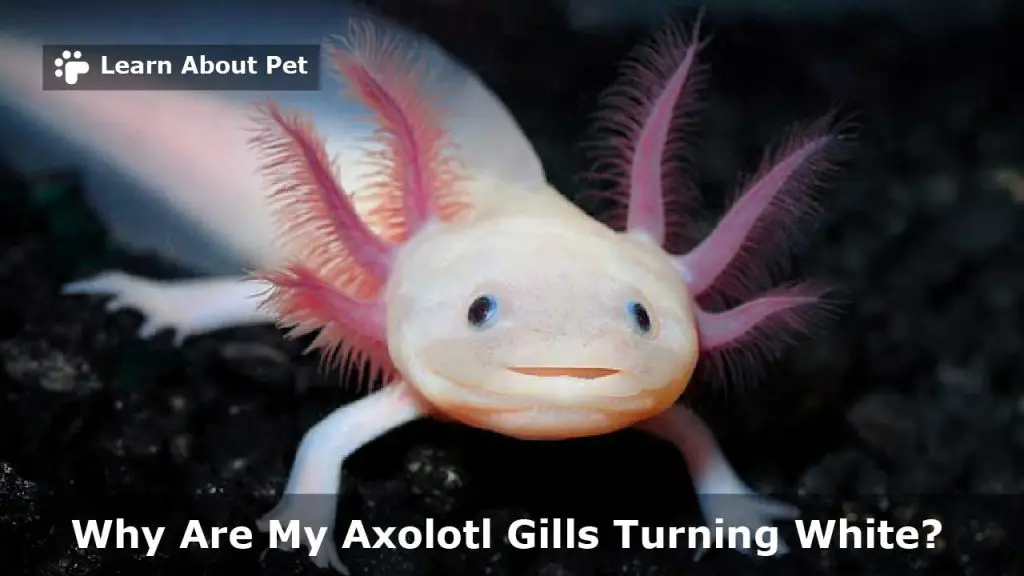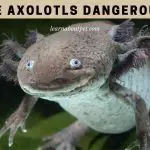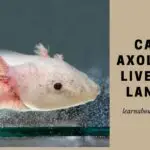Maintaining the health of axolotl is the duty of every axolotl owner. Even though you have taken care of it as much as possible, you have probably ever seen an axolotl in a condition that you have never seen before. Have you ever seen your axolotl have a strange gills condition? For example, axolotl gills appear pale, or axolotl gills turn white over time.
Axolotl gills turning white or looking pale can be due to several factors. When axolotls are stressed due to poor water conditions, their reaction can be seen from their gills. Another possibility is that the axolotl gills are affected by a fungus and need to be treated before it gets worse.
To find out how to deal with axolotl gills that turn white or pale, let’s read this article to the end.

Why Is My Axolotl Gills Turning White?
When an axolotl has problems with its gills, it is a sign that the axolotl is sick or stressed because of the situation in the tank.
The most harmless thing about this is that when axolotls don’t do much activity, their gills have a lighter color. If you have a Leucistic axolotl, their gills will look pink when they are not active and turn red when they are.
If the axolotl gills turning white continuously, then immediately check the condition of the axolotl whether it is sick due to water conditions, eating wrong, or because the gills have an infection or fungus.
Fungus more often appears in axolotl gills such as cotton balls which eventually spread throughout the gills. If you’re not paying attention to this, the fungus can also spread to other parts of the body.
When the skin of the axolotl has been injured, and fungus grows from the wound, it can become a severe infection and worsen the condition of the axolotl.
Do Axolotls Gills Change Colour?
If the axolotl gills change color to lighter, it is a sign of increased blood flow, and there is nothing to worry about. The color change is not permanent. If the axolotl has returned to swimming or taking food, the color of the gills will return to normal.
Axolotl gills become paler when they feel that their water parameters are starting to have problems. If the axolotl float, refusing to eat, then you must immediately check the water condition whether the ammonia or nitrites are at a dangerous level.
Although axolotl gills turning white takes a long time if water conditions deteriorate, it is more dangerous when water conditions have high ammonia levels and can cause axolotl poisoning.
Ammonia at 0.25 ppm alone can make axolotl floating. If left unchecked, the axolotl can be exposed to ammonia burn.
Why Is My Axolotl Changing Color?
Many factors can cause axolotls to change their colors. For example, black melanoids can change color depending on the substrate used. This color change is not permanent, but it can change the appearance for some time.
If the axolotl tank uses white sand, the color of the axolotl will be brighter, and the dark substrate will make the color of the axolotl darker.
Albino axolotls are another example that can change color as they age. When young, there is some albino that has a pure white color. As adults, they change color to golden albino which is a favorite for many axolotl owners. The good thing about that axolotl is the stunning gold or yellowish color.
This is different from axolotl gills turning white because changing their color is only in a few genes, and not all types of axolotls can change the body color. If there is a problem with the gills, you can check the axolotl gills for fungus or parasites.
Don’t wait for the axolotl’s condition to get worse. Fungal infections can worsen the axolotl’s condition, and make it easier for the axolotl to get other diseases.
What Does It Mean When Axolotls Gills Change Color?
There are two possibilities that most often occur when axolotl gills turn white, due to inactivity or there is fungus on axolotl gills.
If the axolotl doesn’t do much activity, their body including the gills will have a paler color. When you give food or interact with them, their heartbeat will go faster, and their blood rushes to their gills.
When the axolotl doesn’t have much activity, the gills will be whiter than usual, but nothing to worry about. You only need to worry if axolotl gills turning white and the axolotl has a fungus on its gills. It looks like a white color that collects at a certain point.
Fungal problems must be removed because there is a possibility that the fungus will grow back. If an axolotl feels something strange on its body due to a fungus, its body condition can deteriorate, and the function of its gills can also be disturbed.
Check the condition of the axolotl from its behavior. If the axolotl is not in top condition, you must immediately know the disease. When the axolotl’s condition gets worse, you need to take the axolotl to the vet.
What Does A Sick Axolotl Look Like?
Sick axolotls can be seen from their gills, tails, and behavior. Curled tails and curled gills are signs when axolotls are in bad water conditions, so they float more to get out of bad water conditions.
If the axolotl starts to get sick, they will refuse to eat, inactivity, floating sideways or upside down, and other weird behaviors. When the disease is severe, the axolotl can lose gills, skin shedding, and getting skinny.
Water conditions are the main thing to avoid any disease. If you use a water filter, you need to change the water once a week with a rule of thumb of 20-30% water change to neutralize ammonia and nitrite levels.
Immediately check using a water test kit to maintain ammonia and nitrites levels at 0 ppm. If the axolotl has started to return to its usual behavior, such as spending time at the bottom of the tank, the desire to eat is high, and swimming around, then your axolotl is back to health.
Axolotl gills turning white when there is fungus are also sick axolotl. Transfer the axolotl to another tank when you want to remove the fungus. Ask for antibiotics or antiseptic for the axolotl affected by the fungus so that it goes away forever and doesn’t come back at the same point.

Axolotl Gills Shrinking
If your axolotl gills are shrinking, there is a problem with the water tank. You can change the water too often or use tap water directly when changing the water even if the ammonia and nitrite levels are at 0 ppm.
If you want to change the water, leave the water for water changes overnight to reduce the chlorines and chloramines that are harmful to the axolotl.
Changing water 20-30% per week is fine but changing too often can stress the axolotls and shrink their gill filaments.
If your axolotl gills turning white, there is a possibility of the water in bad conditions. Move the axolotl to the cycled tank if you want to change the water. Make sure the water in the tank is stable for ammonia and nitrites levels, then return the axolotl to the original tank.
Axolotl White Fungus On Gills
The white fungus will look like fluffy balls and stick to the axolotl gills. You can give treatment to remove axolotl fungus on gills. Transfer the axolotl to dechlorinated water and give it a tea bath or almond leaf as these two ingredients are effective at removing parasites, infections, and fungi.
After letting it soak for a while, you can gently remove the white fungus using cotton buds. Although you can’t completely clean it in one try, you can do this treatment to see if the axolotl gills turning white symptoms can be reduced.
After rubbing your axolotl, but there is still some fungus on the axolotl gills, you can continue with a tea bath. Do not do a salt bath because it can irritate the axolotl skin more severely. Use a tea bath because the content of tea leaves is smoother than salt.
If you can spot the fungus on the gills sooner, then proper treatment can remove the fungus immediately before it spreads to all parts of the axolotl gills.
Axolotl Gills Losing Color
Don’t panic if the axolotl gills turning white or paler than usual because the axolotl could be resting. The axolotl adults usually stay at the bottom of the tank. Axolotl gills will return to their gills color when active, such as when they swim or eat.
If your axolotl gills rot due to fungal infections, immediately take it to the vet. They will remove the fungus first and make sure there is no fungus left. If left unchecked, the fungus will continue to grow, and their gills will continue to rot.
While the rotting problems are still active, the color of the gills will fade, and some will fall off. Although the axolotl has regeneration, the regeneration process will not work when fungal infections are still present.
Take it to the vet so that the fungus will be removed. Give special medicine so that the regeneration process of the axolotl can return to function.
Black Axolotl Turning White
If you have black melanoid axolotls, and the substrate you use is white sand, there is a possibility that the black axolotls will be a lighter color because of the influence of the substrate.
When black melanoids mature, they will often spend time at the bottom of the tank, and the substrate can cause them to change color temporarily. This is not dangerous because it does not cause any infection or disease, only its appearance changes temporarily.
In contrast to axolotl gills turning white due to lack of activity, because when the bloodstream has started smoothly. When the axolotl is active, the color of the gills will return to normal.
If your black axolotls have a white fluffy thing on their gills, then it is a sign that the axolotl gills have been infected with a fungus. Get rid of the fungus immediately before it gets a more severe infection.
Axolotl Diseases
Because the axolotl when sick is related to the color of the gills and their behavior, you must know some diseases that can happen to the axolotl. You can also prevent that from happening. The table below will explain some of the diseases that your axolotl can experience.
| Diseases | Symptoms |
| Columnaris | Lethargy, loss of appetite, white patches |
| Septicemia | Harmful bacteria that penetrate an axolotl’s vital organ |
| Saprolegnia | Fluffy white on axolotl gills, tissue necrosis |
| Whirling disease | Parasites that interfere with animal’s brain function, unnatural swimming, and starvation |
| Overheat | Bloating, floating, loss of appetite |
| New tank syndrome | Redness, shrinking gills, loss of appetite |
| Impaction | Inactivity, floating, stop eating |
Final Verdict – Axolotl Gills Turning White
Why is my Axolotl gills turning white? There are several reasons why axolotls have discolored gills, from harmless to dangerous. The first reason is that the axolotl does not have much activity, so the color is paler than usual.
Adult axolotls are often like this if they are sitting at the bottom of the tank. If the axolotls return to activity, their bloodstream will return, and the color of the gills will return to normal.

Another possibility is that the color of the axolotl gills changes due to poor water conditions. If the water starts to get dirty, the ammonia or nitrites will rise and cause axolotl stress. If left for a few days, the axolotls will float, and the gills will turn paler.
It is potentially dangerous if axolotl gills are exposed to a fungus, which can spread to different parts of the body and cause a severe infection. You need to do a tea bath or give almond leaf to relieve fungal infection symptoms.
If the condition gets worse, you need to take the axolotl to the vet to be given antibiotics and antiseptic for the former infection. Ensure the fungus is completely gone on the axolotl gills.
As a pet lover, make sure to learn about pet more and give your pet axolotl a good and comfortable life!

Welcome to Learn About Pet. My name is Rajkumar Ravichandran and I love all pets, travel, and amazing food. I write about my passion and personal experience caring for multiple pets in this blog! ❤️
Post Disclaimer
DISCLAIMER: THIS BLOG OR WEBSITE, "Learn About Pet", DOES NOT PROVIDE YOU WITH MEDICAL ADVICE AND IS NOT A SUBSTITUTE FOR MEDICAL ADVICE. ALWAYS GET IN TOUCH WITH YOUR PERSONAL VETERINARIAN AND USE INFORMATION HERE AS GENERAL ADVICE.
The information, including but not limited to, text, graphics, images and other material contained on this website are for informational purposes only. No material on this site is intended to be a substitute for professional veterinary advice, food recommendation, diagnosis, or treatment. Always seek the advice of your veterinarian or other qualified health care provider with any questions you may have regarding a medical condition or for pet food related questions.







